Gynecomastia and pseudogynecomastia are conditions that both result in the enlargement of male breast tissue, but they have distinct causes and characteristics. While both conditions can look similar, their treatments differ significantly.
The Difference Between Gynecomastia and Pseudogynecomastia
Gynecomastia and pseudogynecomastia both result in the enlargement of male breast tissue, but they differ in their underlying causes. Gynecomastia is caused by an imbalance of hormones, specifically an increase in estrogen or a decrease in testosterone, leading to the growth of actual breast gland tissue. This condition can be influenced by factors such as puberty, aging, certain medications, and health conditions. In contrast, pseudogynecomastia is due to the accumulation of excess fat in the chest area, often associated with weight gain and obesity, rather than hormonal changes. While gynecomastia may require medical treatments like hormonal therapy or surgery, pseudogynecomastia is typically managed through lifestyle changes such as diet and exercise. Understanding these differences is crucial for determining the appropriate treatment approach.
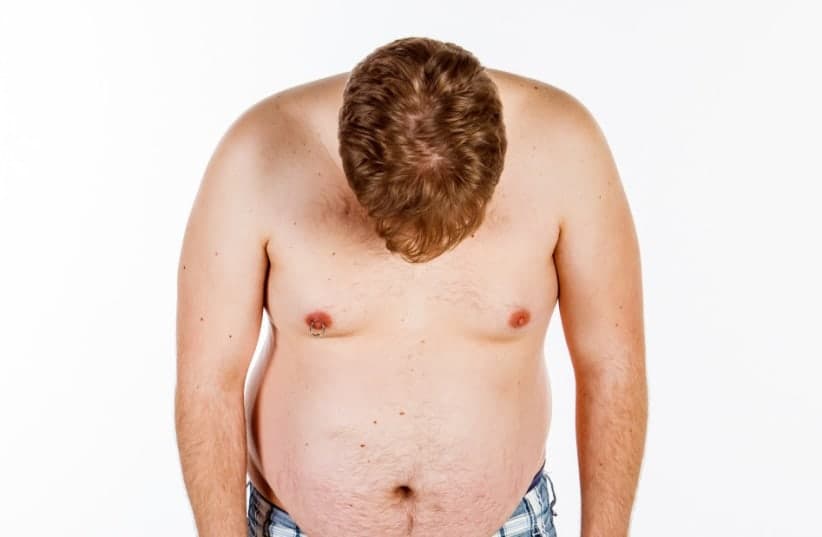
Gynecomastia Symptoms
Gynecomastia, the enlargement of male breast tissue, presents with a variety of symptoms that can affect one or both breasts.
One of the most common symptoms is the presence of a palpable lump or firm mass beneath the nipple, which can be tender or painful, especially in adolescents. This lump is typically symmetrical in shape and may feel rubbery or firm to the touch.
Swelling of the breast tissue is another hallmark symptom, leading to an increase in breast size that can be noticeable and sometimes uneven between the two breasts. This swelling can cause discomfort and sensitivity, particularly when the breasts are touched or rubbed against clothing.
Pain and tenderness are frequent complaints among those with gynecomastia, with the intensity of pain varying from mild to severe. This pain is often described as a dull ache or a sharp, stabbing sensation, and it can be exacerbated by physical activity or pressure on the chest area.
Additionally, some individuals may experience nipple discharge, which can be alarming but is usually benign. This discharge can be clear, milky, or even bloody, and it warrants medical evaluation to rule out other conditions.
The psychological impact of gynecomastia should not be underestimated. The physical changes can lead to significant emotional distress, including feelings of embarrassment, anxiety, and low self-esteem. This is particularly true for adolescents, who may be more sensitive to body image issues and peer perceptions. The condition can also affect social interactions and participation in activities such as swimming or sports, where the chest area is more exposed.
In rare cases, gynecomastia can be associated with more serious underlying conditions, such as hormonal imbalances, liver disease, or tumors. Therefore, it is important for individuals experiencing symptoms of gynecomastia to seek medical evaluation to determine the underlying cause and appropriate treatment.
Diagnostic tests required for gynecomastia may include blood tests to check hormone levels, imaging studies like mammograms or ultrasounds, and sometimes tissue biopsies to rule out malignancy.

Pseudogynecomastia Symptoms
Pseudogynecomastia, often confused with gynecomastia, is characterized by the accumulation of excess fat in the male chest area, leading to the appearance of enlarged breasts. Unlike gynecomastia, which involves the growth of glandular breast tissue due to hormonal imbalances, pseudogynecomastia is purely a result of increased adipose (fat) tissue.
The primary symptom of pseudogynecomastia is the noticeable enlargement of the chest, which can be bilateral (affecting both breasts) or unilateral (affecting one breast). This enlargement is typically soft and pliable to the touch, as opposed to the firmer glandular tissue found in gynecomastia.
Men with pseudogynecomastia often notice that their chest size fluctuates with changes in their overall body weight. Weight gain tends to exacerbate the condition, making the breasts appear larger, while weight loss can reduce the size of the chest. This is because the fat cells in the chest area expand or shrink in response to changes in body fat. Unlike gynecomastia, pseudogynecomastia does not usually cause pain or tenderness in the breast tissue.
Another symptom of pseudogynecomastia is the distribution of fat around the chest and armpit region. This can give the chest a more rounded appearance, and in some cases, the fat may extend to the sides of the chest, creating a more pronounced look. The skin overlying the fat deposits is typically normal in texture and color, without any signs of inflammation or abnormal growths.
Psychologically, pseudogynecomastia can have a significant impact on a man's self-esteem and body image. The condition can lead to feelings of embarrassment and self-consciousness, particularly in situations where the chest is exposed, such as at the beach or during physical activities. This can result in social withdrawal and a reluctance to participate in activities that involve removing one's shirt.
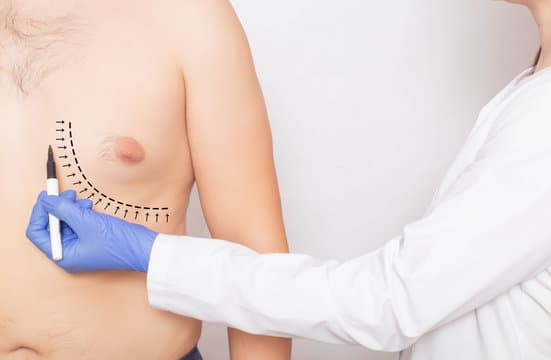
Gynecomastia Causes
There are a number of causes that can result in gynecomastia, enlargement of male breast tissue, which include:
Gynecomastia, the enlargement of breast tissue in males, is primarily caused by an imbalance between the hormone’s estrogen and testosterone. This condition can occur at various stages of life, including infancy, puberty, and older adulthood, due to natural hormonal fluctuations. During puberty, for instance, hormonal changes can lead to temporary gynecomastia, which usually resolves on its own within six months to two years. In older adults, decreased testosterone production and increased body fat, which can convert testosterone to estrogen, often contribute to the development of gynecomastia.
Several medical conditions can also lead to gynecomastia. Hypogonadism, a condition characterized by low testosterone levels, is a common cause. Hyperthyroidism, where the thyroid gland produces excessive hormones, can also disrupt the balance of sex hormones, leading to gynecomastia. Additionally, chronic diseases such as liver cirrhosis and kidney failure can alter hormone metabolism and contribute to the condition.
Certain medications are known to cause gynecomastia as a side effect. These include anti-androgens used to treat prostate cancer, anabolic steroids, some anti-anxiety medications, tricyclic antidepressants, and certain antibiotics. Medications for heart conditions, such as calcium channel blockers and digoxin, as well as treatments for ulcers, like cimetidine, have also been implicated. Furthermore, substances like alcohol, marijuana, heroin, and methadone can contribute to the development of gynecomastia.
Tumors that affect hormone levels can also be a cause. Tumors of the testes, adrenal glands, or pituitary gland can alter the balance of hormones in the body, leading to gynecomastia. In rare cases, genetic disorders such as Klinefelter syndrome, which involves an extra X chromosome, can cause gynecomastia due to abnormal hormone levels.
Lifestyle factors and diet can play a role as well. Obesity is a significant risk factor because excess fat tissue can increase estrogen levels in the body. Malnutrition and starvation, followed by refeeding, can also lead to hormonal imbalances that cause gynecomastia.
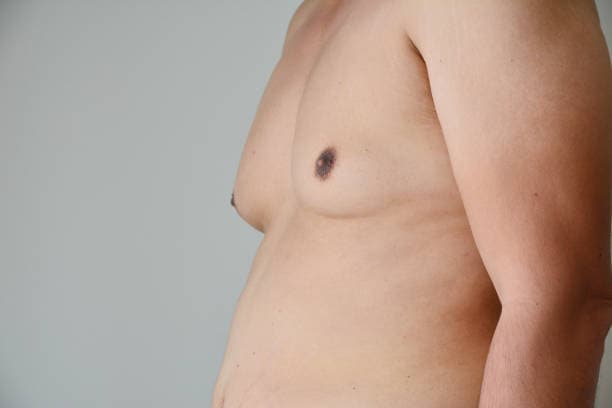
Pseudogynecomastia Causes
Pseudogynecomastia, often mistaken for gynecomastia, is characterized by the accumulation of excess fat in the chest area of men, leading to the appearance of enlarged breasts. Unlike gynecomastia, which involves the proliferation of glandular breast tissue, pseudogynecomastia is solely due to fatty tissue.
The primary cause of pseudogynecomastia is weight gain, which can result from various factors including poor diet, lack of physical activity, and genetic predisposition. Obesity is a significant contributor, as excess caloric intake and insufficient energy expenditure lead to fat deposition in various parts of the body, including the chest.
Hormonal imbalances can also play a role in the development of pseudogynecomastia. Fluctuations in hormones, particularly an increase in estrogen or a decrease in testosterone, can lead to fat accumulation in the chest area. This hormonal imbalance can be due to several reasons, such as aging, certain medications, or underlying health conditions like hypogonadism or hyperthyroidism. Additionally, lifestyle factors such as alcohol consumption and the use of anabolic steroids can exacerbate hormonal imbalances, further contributing to the condition.
Certain medical conditions can also lead to pseudogynecomastia. For instance, liver disease can affect the metabolism of hormones, leading to an imbalance that promotes fat deposition in the chest. Similarly, conditions that limit physical activity, such as chronic illnesses or injuries, can result in weight gain and subsequent pseudogynecomastia.
Genetic factors may predispose some individuals to store fat in specific areas of the body, including the chest, making them more susceptible to developing pseudogynecomastia.
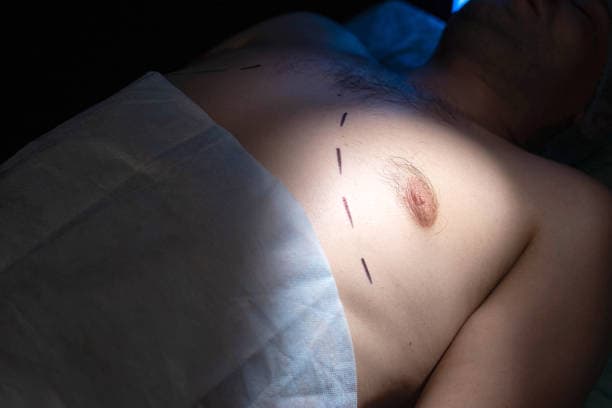
Gynecomastia Treatment options
Gynecomastia, the enlargement of breast tissue in males, can be a source of physical discomfort and emotional distress. Treatment options for gynecomastia vary depending on the underlying cause, severity, and the individual's preferences. Here are some common approaches:
Observation and Lifestyle Changes: In many cases, gynecomastia resolves on its own, especially if it occurs during puberty. Doctors may recommend a period of observation to see if the condition improves without intervention. Lifestyle changes, such as losing weight and avoiding substances that can exacerbate gynecomastia (like alcohol, anabolic steroids, and certain medications), can also be beneficial.
Medications: When gynecomastia is caused by hormonal imbalances, medications may be prescribed to address the issue. Selective estrogen receptor modulators (SERMs) like tamoxifen and raloxifene can help reduce breast tissue size. Aromatase inhibitors, which reduce estrogen levels, may also be used in some cases.
Hormone Therapy: For individuals with significant hormonal imbalances, hormone therapy might be an option. This can involve testosterone replacement therapy if low testosterone levels are contributing to the condition.
Surgery: In cases where gynecomastia is severe or persistent, surgical options may be considered. There are two main types of surgery for gynecomastia: Liposuction to remove the excess fat from the breast, or Mastectomy to remove the glandular breast tissue.
Psychological Support: Gynecomastia can have a significant impact on an individual's self-esteem and mental health. Counseling or support groups can be valuable resources for those struggling with the emotional aspects of the condition.
Addressing Underlying Conditions: If gynecomastia is caused by an underlying health condition, such as hyperthyroidism, kidney failure, or liver disease, treating that condition can help alleviate the symptoms of gynecomastia.
Each treatment option has its own risks and benefits, and the best approach depends on the individual's specific situation. Consulting with a healthcare provider is crucial to determine the most appropriate treatment plan.
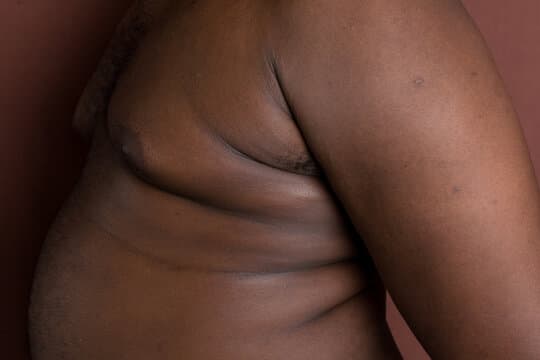
Pseudogynecomastia Treatment options
Pseudogynecomastia, characterized by the accumulation of excess fatty tissue in the male chest area, can be effectively managed through various treatment options.
The first line of treatment typically involves lifestyle modifications, including a balanced diet and regular exercise. Weight loss through these means can significantly reduce the appearance of pseudogynecomastia, as the condition is often linked to overall body fat percentage. For individuals who struggle with weight loss due to medical conditions or other factors, more intensive interventions may be necessary.
One of the most common and effective surgical treatments for pseudogynecomastia is liposuction. This minimally invasive procedure involves the removal of excess fat deposits from the chest area. Tumescent liposuction, a popular technique, involves injecting a solution to expand the treatment area, making it easier to suction out the fat cells without damaging surrounding tissues. Depending on the severity of the condition, liposuction alone may suffice, particularly in cases classified as grade 1 or 2 pseudogynecomastia. However, more advanced cases (grades 3 and 4) might require additional skin excision to achieve a contoured chest appearance.
In addition to surgical options, non-surgical treatments are also available. Compression garments can provide temporary relief by flattening the chest area and improving the overall appearance. These garments are particularly useful for individuals seeking a non-invasive solution or those who are not candidates for surgery.
Furthermore, certain medications may be prescribed to address underlying hormonal imbalances that contribute to fat accumulation in the chest. For instance, anti-estrogen medications can help reduce estrogen levels, thereby minimizing fat storage.
For some men, bariatric surgery, such as gastric bypass, may be considered if obesity is a significant contributing factor to pseudogynecomastia. This procedure can lead to substantial weight loss, which in turn can reduce the fatty tissue in the chest. However, this option is typically reserved for individuals with severe obesity who have not responded to other weight loss methods.

Conclusion
In conclusion, while both gynecomastia and pseudogynecomastia result in the enlargement of the male chest, their underlying causes and treatment approaches differ significantly. Gynecomastia may require medical treatments like hormone therapy or surgical intervention to remove the excess glandular tissue. Treatment for pseudogynecomastia typically focuses on lifestyle modifications, such as diet and exercise, and may include liposuction for more severe cases. Understanding these distinctions is crucial for selecting the appropriate treatment and achieving the best possible outcomes for individuals affected by these conditions.
Read More